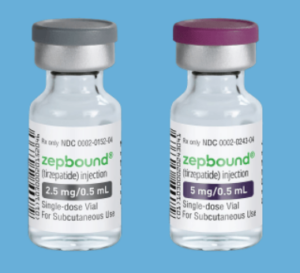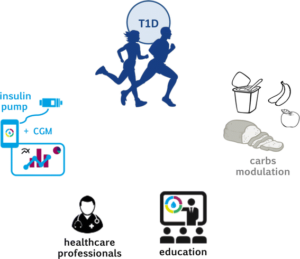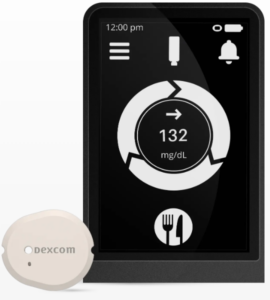Dexcom prices first over-the-counter glucose monitor by Elise Reuter for MedTechDive.com, 26 August 2024.
 Diabetes technology company Dexcom began selling its first over-the-counter continuous glucose monitor (CGM) on Monday. The device, called Stelo, will cost $89 for a monthly subscription or $99 for a one-time order of two sensors. BTIG analyst Marie Thibault said the price was “in line with our prior $100 per month assumption.” Dexcom’s device is intended for people with Type 2 diabetes who don’t take insulin, although it can be used by people without diabetes.
Diabetes technology company Dexcom began selling its first over-the-counter continuous glucose monitor (CGM) on Monday. The device, called Stelo, will cost $89 for a monthly subscription or $99 for a one-time order of two sensors. BTIG analyst Marie Thibault said the price was “in line with our prior $100 per month assumption.” Dexcom’s device is intended for people with Type 2 diabetes who don’t take insulin, although it can be used by people without diabetes.
Competitor Abbott plans to launch two over-the-counter CGMs: one called Lingo, for people without diabetes, and one called Libre Rio, for people with diabetes who don’t use insulin. It has not yet priced either sensor.
Read more:
Lilly slashes prices on two lowest doses of Zepbound — if you’re willing to give up injector pen by Berkeley Lovelace Jr. for NBCNews.com, 27 August 2024.
 Drugmaker Eli Lilly is significantly lowering the prices of the two lowest doses of its blockbuster weight loss drug Zepbound, it said Tuesday, in a move to expand access and ease supply constraints.
Drugmaker Eli Lilly is significantly lowering the prices of the two lowest doses of its blockbuster weight loss drug Zepbound, it said Tuesday, in a move to expand access and ease supply constraints.
Under the new pricing plan, a month’s supply of the lowest dose, 2.5 milligrams, will cost $399, while a month’s supply of the 5 mg dose will cost $549. That’s down from a monthly list price of $1,059, regardless of the dosage.
The lower-cost doses will be offered only through Lilly’s telehealth platform, LillyDirect, however, and they won’t be covered by insurance, meaning patients will need to pay for them in cash. Patients who opt for the lower-cost doses also won’t qualify for Lilly’s discount savings program.
OH, come on, Lilly! Dr. Maria Daniela Hurtado Andrade, an endocrinologist at the Mayo Clinic in Jacksonville, Florida, questioned who would benefit from the lower-cost versions. The $399 price for the lowest dose is still almost $5,000 a year — an insurmountable cost for many racial and ethnic minorities, she said. “The majority of patients will not be able to afford the medication, still,” Hurtado Andrade said. The move to only cut the prices of the lowest doses, she added, may also backfire. People may feel negatively about being limited to the lower doses, while the more effective options are reserved for the wealthy and those who can afford them. “We’re only giving people a taste of hope,” she said.
Read more: Lilly slashes prices on two lowest doses of Zepbound — if you’re willing to give up injector pen
Personal CGM use in hospitals feasible, preferred by nurses and patients by Michael Monostra for Healio.com/endocrinology, 26 August 2024.
 A change to hospital policy allowing patients to use their own continuous glucose monitors instead of finger-stick blood glucose monitoring was met favorably by a majority of patients and nurses, according to study findings. In November 2022, Stanford Health Care put a new policy into effect allowing the use of personal CGM for inpatient care. A subcommittee of the system’s inpatient diabetes task force created a policy addressing nursing protocol for validating CGM with finger-stick blood glucose testing and the use of inpatient CGM.
A change to hospital policy allowing patients to use their own continuous glucose monitors instead of finger-stick blood glucose monitoring was met favorably by a majority of patients and nurses, according to study findings. In November 2022, Stanford Health Care put a new policy into effect allowing the use of personal CGM for inpatient care. A subcommittee of the system’s inpatient diabetes task force created a policy addressing nursing protocol for validating CGM with finger-stick blood glucose testing and the use of inpatient CGM.
“Our patients asked if they could use their CGMs, as they were frustrated with having to do frequent finger sticks, even though they had these devices,” Michael Hughes, MD, instructor in the division of endocrinology, gerontology and metabolism at Stanford University School of Medicine, told Healio. “Some of our nurses noticed this issue too, so we sought to make it happen as a team. We found a way to reduce the number of finger sticks while still keeping an eye on the CGMs to make sure they were accurate. In the end, patients were glad to see fewer finger sticks and have their CGMs become a part of their care.”
Read more: Personal CGM use in hospitals feasible, preferred by nurses and patients
GluFormer outperforms existing AI models in predicting blood sugar levels by Dr. Chinta Sidharthan for News-Medical.net, 26 August 2024.
 In a recent study posted to the arXiv* preprint* server, scientists from Israel presented a transformer architecture-based generative model for analyzing continuous glucose monitoring data and predicting glycemic patterns. This model has applications in risk stratification, diabetes care, and treatment strategy optimization.
In a recent study posted to the arXiv* preprint* server, scientists from Israel presented a transformer architecture-based generative model for analyzing continuous glucose monitoring data and predicting glycemic patterns. This model has applications in risk stratification, diabetes care, and treatment strategy optimization.
Continuous glucose monitoring (CGM) devices have been instrumental in improving diabetes management by lowering the frequency of glycemic events, improving glycemic control, and enhancing the overall quality of life. In parallel, medical artificial intelligence (AI) is progressing towards self-supervised learning that can analyze large amounts of unlabeled data, such as those gathered by CGM devices. Trained self-supervised learning models are effectively used to scan data from wearables and histopathological and retinal images to detect diseases.
In the present study, the researchers described the development of a transformer architecture-based generative model called GluFormer that can analyze large amounts of CGM data from diverse populations. The model was initially trained on CGM data from non-diabetic participants enrolled in the Human Phenotype Project. This dataset consisted of over 10 million glucose measurements from 10,000 participants. Each measurement was treated as a discrete token, which was used to train the model using the next-token prediction method efficiently. This training method enabled GluFormer to generate and extend the CGM time series. Furthermore, using self-supervised learning to pre-train the model enabled it to learn from unlabeled data, enhancing GluFormer’s ability to capture the complex patterns in the CGM data.
Read more: GluFormer outperforms existing AI models in predicting blood sugar levels
Is real-time blood sugar control becoming a reality with smart insulin? by Katharine Lang for MedicalNewsToday.com, 26 August 2024.
 Smart insulins, or “glucose-responsive” insulins, are the latest in a range of novel insulins being developed in the search for better treatments for type 1 diabetes. The Type 1 Diabetes Grand Challenge, which is supported by Diabetes UK, JDRF and the Steve Morgan Foundation, has allocated £2.7 million to fund six research projects into new diabetes treatments.
Smart insulins, or “glucose-responsive” insulins, are the latest in a range of novel insulins being developed in the search for better treatments for type 1 diabetes. The Type 1 Diabetes Grand Challenge, which is supported by Diabetes UK, JDRF and the Steve Morgan Foundation, has allocated £2.7 million to fund six research projects into new diabetes treatments.
Novel insulins under development include:
-
-
- Fast-acting insulins — these are insulins that have been chemically edited so they are absorbed faster by the body and can reduce blood glucose levels rapidly. Some ultra rapid insulins can reach the blood in 4-7 minutes, around half the time taken by currently available insulins.
- Weekly injections — to try and help remove the chore of daily injections, the drug company Novo Nordisk is developing a form of insulin, called insulin icodec, that is injected only once a week. Although a long way from being a marketable treatment, this has shown promise in the ONWARDS 6 trial of 582 people with type 1 diabetes.
- Oral — researchers from Australia and Norway have developed a capsule that is taken by mouth and travels through the digestive system to the liver. The covering of the capsule prevents the insulin being broken down by stomach acid or digestive enzymes on its journey. Once in the liver, tiny particles called nanocarriers that are attached to the insulin molecules detect increased glucose levels and release their insulin as needed. Clinical trials are due to start in 2025.
- Smart capsules — scientists at the University of Birmingham in the United Kingdom are developing a capsule that could be injected once a week. The theory is that the capsule would slowly degrade, releasing insulin whenever blood glucose gets too high. However, this treatment is in the early stages of development, so it could be many years before trails in people can begin.
- Smart, or “glucose-responsive” insulins — these are administered once a day, and remain inactive in the body until blood glucose levels rise. When this happens, they respond rapidly to bring the level down before returning to the inactive state.
-
Read more: Is real-time blood sugar control becoming a reality with smart insulin?
New Study Reveals Best Forms of Exercise for Diabetes by Staffordshire University and reported by SciTechDaily.com, 25 August 2024.
 A new study highlights that the best type of exercise for managing type-1 diabetes varies by gender, with men benefiting from tailored interval exercises based on their initial blood sugar levels, and women responding well to both interval and continuous exercises. This research supports personalized exercise guidelines to prevent hypoglycemia. A recent study has identified the most effective forms of exercise for individuals with type-1 diabetes. The research was led by the Universidade Federal do Vale do São Francisco in partnership with Staffordshire University to investigate training optimization for diabetic patients.
A new study highlights that the best type of exercise for managing type-1 diabetes varies by gender, with men benefiting from tailored interval exercises based on their initial blood sugar levels, and women responding well to both interval and continuous exercises. This research supports personalized exercise guidelines to prevent hypoglycemia. A recent study has identified the most effective forms of exercise for individuals with type-1 diabetes. The research was led by the Universidade Federal do Vale do São Francisco in partnership with Staffordshire University to investigate training optimization for diabetic patients.
“This study is important because diabetic patients often lack motivation to exercise as a means of managing their condition,” explained Dr Pooya Soltani from Staffordshire University. “One reason for this is that physical activity can lead to blood sugar drops, causing discomfort and demotivation. We investigated whether the type of physical activity could mitigate these blood sugar drops.”
Dr Jorge Luiz de Brito-Gomes from Universidade Federal do Vale do São Francisco said: “Our study showed that for male patients, interval exercise, such as short bursts of walking, is preferable when starting with low blood sugar levels. Conversely, continuous exercise, like running, is more suitable for those with higher initial blood sugar levels. These approaches can help prevent sudden blood sugar drops.
“For female patients, both interval and continuous aerobic exercise appear to be effective starting points. We hope these findings show that gender-specific recommendations should be considered for aerobic exercise prescription, especially for men with irregular physical activity levels.”
Read more: New Study Reveals Best Forms of Exercise for Diabetes
PBM executives threatened with fines and jail time for alleged perjury in House hearing by Rebecca Pifer for HealthCareDive.com, 29 August 2024.
 The chair of the powerful House Committee on Oversight and Accountability is threatening the leaders of the three largest pharmacy benefit managers in the country with steep fines — or jail time — for allegedly lying in a recent congressional hearing.
The chair of the powerful House Committee on Oversight and Accountability is threatening the leaders of the three largest pharmacy benefit managers in the country with steep fines — or jail time — for allegedly lying in a recent congressional hearing.
Chairman James Comer, R-Ky., sent letters to Patrick Conway, the CEO of UnitedHealth’s Optum Rx; Adam Kautzner, the president of Cigna’s Express Scripts; and David Joyner, the president of CVS’ Caremark arguing that statements they made in a July 2024 hearing contradicted committee findings and research by the Federal Trade Commission.
During the hearing, Conway, Kautzner and Joyner testified that their PBMs treat affiliated and unaffiliated pharmacies equally when setting rates, negotiating contracts and telling patients where to dispense their medications. Those statements were lies, suggests Comer’s letters, which cite committee and FTC evidence to argue that PBMs increase revenue at their own pharmacies at the expense of other businesses.
Comer asked the executives to correct their statements by Sept. 11 or face possible legal action — including up to five years in jail, in addition to fines that could reach hundreds of thousands of dollars.
Read more: PBM executives threatened with fines and jail time for alleged perjury in House hearing
Beta Bionics Hits 10,000 iLet Bionic Pancreas Users by Jane Smile for CGMMonitors.com, 20 August 2024.
 Beta Bionics has declared that its iLet bionic pancreas system has now been used by 10,000 patients.
Beta Bionics has declared that its iLet bionic pancreas system has now been used by 10,000 patients.
The iLet uses an advanced, closed-loop algorithm that only needs the user’s body weight to start. This means users don’t have to set up insulin dosing parameters manually. The system handles all insulin calculations and adjustments automatically. Last year, Beta Bionics introduced the iLet with the Dexcom G7 continuous glucose monitor (CGM). Users can choose between the G7 or the earlier G6 model, or switch between them as needed.
Read more: Beta Bionics Hits 10,000 iLet Bionic Pancreas Users
Choose your cheese wisely by Diabetes Care for DiabetesCareCommunity.ca, 19 August 2024.
 Given its deliciousness and versatility, it’s no wonder some 20 million metric tons of cheese is produced each year around the world. But do cheese and diabetes make a good mix? The answer is yes, with a few provisions of course.
Given its deliciousness and versatility, it’s no wonder some 20 million metric tons of cheese is produced each year around the world. But do cheese and diabetes make a good mix? The answer is yes, with a few provisions of course.
The following nutrient information is for a 1-ounce (30g) serving of cheese:
Cheese is a good source of protein and bone-building calcium, as well as vitamins A, B2 and B12. The good news for people with diabetes is that cheese is also a low-GI food, which means it won’t spike your blood sugars.
Limitations of cheese: Unfortunately, cheese can also be high in sodium (especially processed and hard cheeses like parmesan) and also has saturated fat. Both of these are risk factors for heart disease. Cheese can also be high in calories, which is a key consideration, especially for those trying to lose weight.
Read more: Choose your cheese wisely


PBM executives in jail? Where can i sign up to throw away the key?
I mistrust Ilet not because i do not believe someone has used it, I believe that. I mistrust them because they refuse to discuss current supply sales. OK, if you have 10K uses, then what is your month over month supply sales. That is the real number.